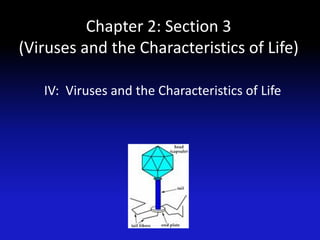
Chapter 2 section 3 (viruses) 2011
- 1. Chapter 2: Section 3 (Viruses and the Characteristics of Life) IV: Viruses and the Characteristics of Life
- 2. A. What is a Virus? 1. Virus: A strand of hereditary material surrounded by a protein coat. 2. Viruses do not have a nucleus, organelles, or a cell membrane. 3. Viruses come in a variety of shapes. 4. Viruses are too small to be seen without an electron microscope. a. Because of this viruses are new to the science and medical world.
- 3. 5. The only life characteristic a virus demonstrates is the ability to reproduce. a. Viruses can only reproduce when they are inside of a living cell; if they are outside a cell they do NOTHING. 6. A virus can be frozen for years then thaw out and have the ability to reproduce once inside a living cell!!! 7. Viruses are specific for certain cell types. a. Example: AIDS attacks blood and sex cells; Chicken Pox attacks skin cells, colds attack the respiratory system.
- 4. 8. Viruses can attack ANY living thing; animals, plants, fungi, protists and even bacteria!!! 9. Most viruses attack a specific cell type of a specific organism. a. Example: Tobacco virus attacks only certain cells on the tobacco plant. 10. Some viruses can attack more than one organism. a. Rabies can attack most warm blooded animals.
- 5. Parts of a virus a. Head (Capsule) b. Tail c. End Plate d. Tail Fibers
- 6. Adenovirus and Flu Virus
- 7. B. How a Virus Enters a Cell 1. Virus must find and identify the correct type of cell. a. Viruses and cells fit like a puzzle; or like a lock and key. 2. Once the virus has found the right type of cell it attaches to the outside of that cell. 3. The virus injects its DNA inside the cell. 4. The virus DNA kills everything inside the cell. 5. The virus DNA then duplicates (makes baby viruses) inside the cell. 6. Once the viruses are mature enough they break out of the cell. 7. The new viruses then move on to attack more of the specific cell type.
- 9. C. Types of Viruses 1. Viruses must be inside of a living cell in order to reproduce; these cells are called HOST CELLS. 2. Active Viruses a. If a virus is active it will immediately start the cycle of making new viruses. b. Active viruses make you sick pretty quickly. c. Examples: Colds, Flus, Chicken Pox.
- 10. 3. Latent Viruses a. Once inside the cell the DNA rests for a period of time before it starts to reproduce. b. These viruses can be latent for YEARS, then for some reason they activate and start reproducing. c. Some Latent Viruses never stop once they start reproducing while others may go back to a dormant or latent state. d. Examples: HIV, Cold Sores, Herpes, Warts.
- 11. 4. Bacteriophages a. Viruses that attack bacteria. b. Very fast reproducing viruses; can reproduce every 20 minutes.
- 12. D. What is a Vaccine 1. Vaccine: a shot made from weakened virus particles that can’t cause disease anymore. 2. Once introduced to your body they trick your body into making antibodies to destroy the disease in the future. 3. Examples of viral disease that we have vaccines: a. Chicken Pox, Measles, Mumps, Rabies, Polio 4. Edward Jenner created the first vaccine in 1796. a. Created a vaccine for a disease called smallpox which is now almost completely extinct from Earth.
- 13. E. How Do We fight Viruses? 1. There is no medicine that we can use to kill a virus. 2. Your body can fight some viruses by making interferons. a. Interferons are proteins that protect the non-infected cells. b. This is how you body destroys viruses that are inside of your cells. 3. However there are some viral diseases that your body will never make interferons against such as HIV. (HIV is the virus, AIDS is the disease caused by the virus).
- 14. 4. Gene Therapy is an advanced used today to help destroy viruses. a. Gene therapy is a process that takes the bad DNA out of an infected cell and replaces it with good DNA. b. Gene therapy helps the cell behave the way it did before the infection. c. This therapy is showing promise in the race against viral diseases, some cancers, and genetic disorders. d. Gene Therapy is not completely successful today, however we continue to study this practice to help destroy viruses.